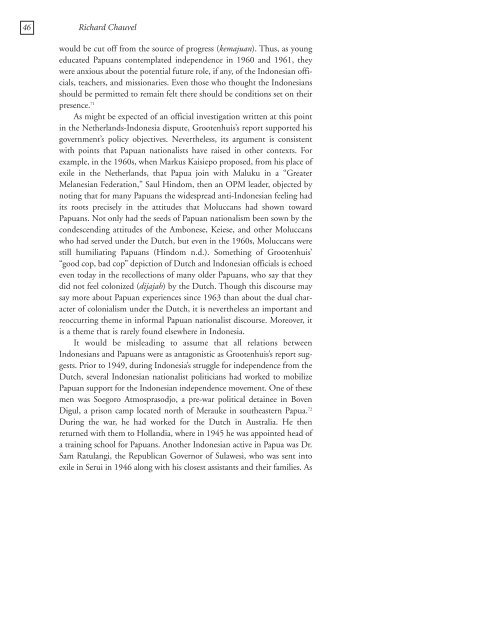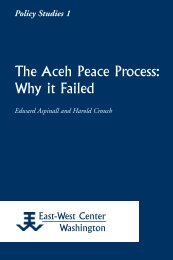Constructing Papuan Nationalism: History, Ethnicity ... - ScholarSpace
Constructing Papuan Nationalism: History, Ethnicity ... - ScholarSpace
Constructing Papuan Nationalism: History, Ethnicity ... - ScholarSpace
- No tags were found...
You also want an ePaper? Increase the reach of your titles
YUMPU automatically turns print PDFs into web optimized ePapers that Google loves.
46 Richard Chauvelwould be cut off from the source of progress (kemajuan). Thus, as youngeducated <strong>Papuan</strong>s contemplated independence in 1960 and 1961, theywere anxious about the potential future role, if any, of the Indonesian officials,teachers, and missionaries. Even those who thought the Indonesiansshould be permitted to remain felt there should be conditions set on theirpresence. 71As might be expected of an official investigation written at this pointin the Netherlands-Indonesia dispute, Grootenhuis’s report supported hisgovernment’s policy objectives. Nevertheless, its argument is consistentwith points that <strong>Papuan</strong> nationalists have raised in other contexts. Forexample, in the 1960s, when Markus Kaisiepo proposed, from his place ofexile in the Netherlands, that Papua join with Maluku in a “GreaterMelanesian Federation,” Saul Hindom, then an OPM leader, objected bynoting that for many <strong>Papuan</strong>s the widespread anti-Indonesian feeling hadits roots precisely in the attitudes that Moluccans had shown toward<strong>Papuan</strong>s. Not only had the seeds of <strong>Papuan</strong> nationalism been sown by thecondescending attitudes of the Ambonese, Keiese, and other Moluccanswho had served under the Dutch, but even in the 1960s, Moluccans werestill humiliating <strong>Papuan</strong>s (Hindom n.d.). Something of Grootenhuis’“good cop, bad cop” depiction of Dutch and Indonesian officials is echoedeven today in the recollections of many older <strong>Papuan</strong>s, who say that theydid not feel colonized (dijajah) by the Dutch. Though this discourse maysay more about <strong>Papuan</strong> experiences since 1963 than about the dual characterof colonialism under the Dutch, it is nevertheless an important andreoccurring theme in informal <strong>Papuan</strong> nationalist discourse. Moreover, itis a theme that is rarely found elsewhere in Indonesia.It would be misleading to assume that all relations betweenIndonesians and <strong>Papuan</strong>s were as antagonistic as Grootenhuis’s report suggests.Prior to 1949, during Indonesia’s struggle for independence from theDutch, several Indonesian nationalist politicians had worked to mobilize<strong>Papuan</strong> support for the Indonesian independence movement. One of thesemen was Soegoro Atmosprasodjo, a pre-war political detainee in BovenDigul, a prison camp located north of Merauke in southeastern Papua. 72During the war, he had worked for the Dutch in Australia. He thenreturned with them to Hollandia, where in 1945 he was appointed head ofa training school for <strong>Papuan</strong>s. Another Indonesian active in Papua was Dr.Sam Ratulangi, the Republican Governor of Sulawesi, who was sent intoexile in Serui in 1946 along with his closest assistants and their families. As
















